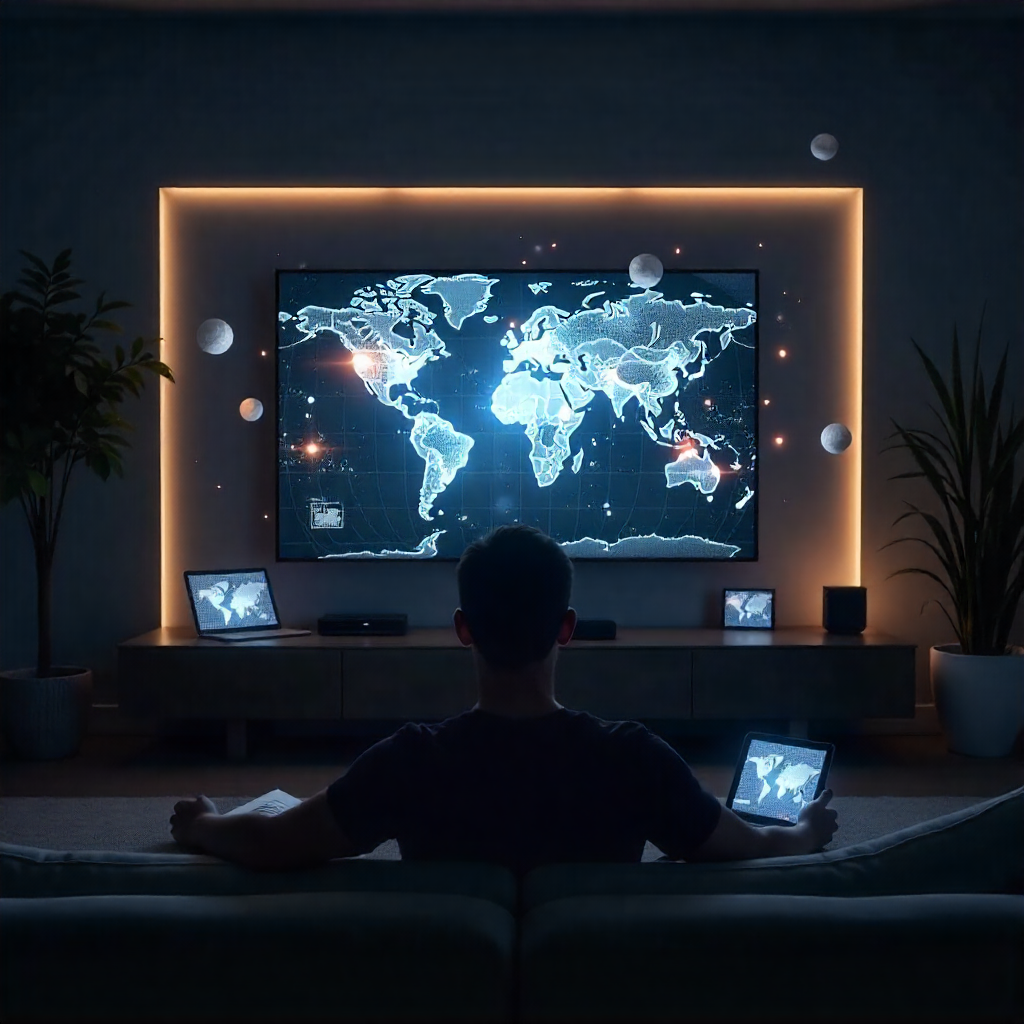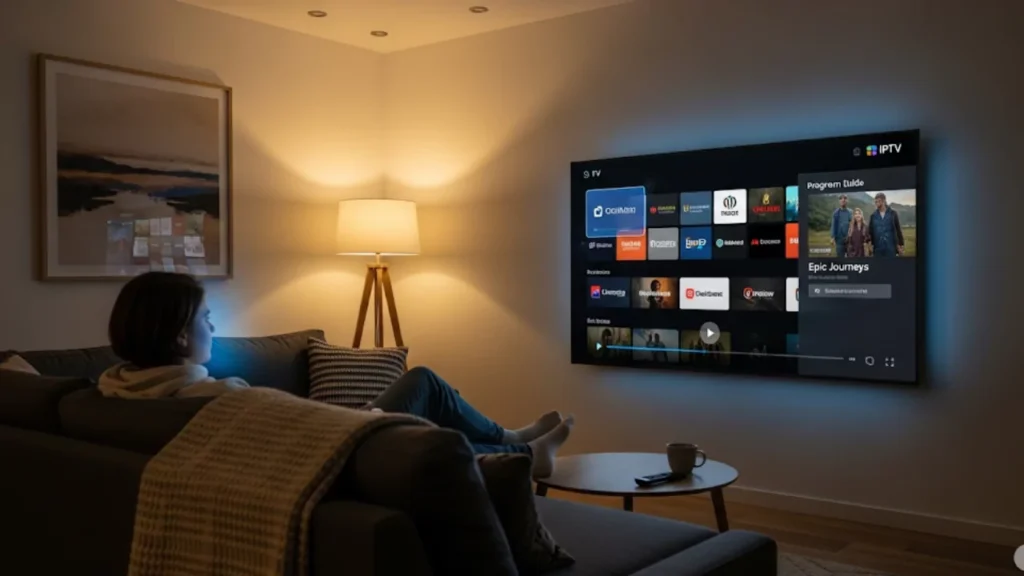Ever wondered how your favorite shows stream seamlessly to your device? The way we watch television has been altered by IPTV meaning, or Internet Protocol Television. It offers live channels, video on demand, and interactive features via your internet. This is different from using traditional cable TV.
IPTV stands for Internet Protocol Television. It streams live TV and on-demand videos through the internet. You don’t need cables or satellites. It works across smart TVs, smartphones, and set-top boxes. IPTV provides flexibility and personalization. It also offers global access. This makes it the future of entertainment and digital broadcasting.
History and Evolution of IPTV
Internet Protocol television kicked off in the early 1990s. Telecom companies tested how to deliver video content using digital subscriber line connections. At first, IPTV services had limits due to bandwidth needs. They also needed special IPTV boxes at local telecom centers.
Early IPTV Service Providers faced significant challenges with content delivery and streaming protocols. The technology depended on fiber-optic cables. It also needed a lot of money from Internet Service Providers. As internet connections got faster and 4K streaming became an option, IPTV subscriptions saw a huge rise.
Today’s IPTV services have evolved far beyond basic live television delivery. Modern platforms such as Apple TV, Prime Video, and Pluto TV show how Internet protocol TV has changed. They now provide complete entertainment systems. Users enjoy on-demand content, interactive features, and personalized profiles.
What Components Make IPTV Work?
Core Components: Video Servers and Content Delivery Networks
The heart of every IPTV service is solid video servers and a reliable content delivery network. These systems keep large libraries of TV shows, live TV channels, and on-demand videos. Content delivery networks help streaming run smoothly. They share content on many servers. This cuts down latency and boosts viewing quality at your local streaming spot.
Streaming servers receive content from various sources. They then encode it into different formats for different devices. This process makes playback smooth on Smart TVs, streaming sticks, Fire TV Stick, and mobile apps.
Streaming Protocols and Technologies
Several streaming protocols power modern IPTV services:
- Real-Time Streaming Protocol (RTSP) manages the delivery of live content and TV broadcasts.
- MPEG-DASH protocol: provides adaptive streaming. It changes the quality based on your internet speed.
- Hypertext Transfer Protocol (HTTP): Enables on-demand content delivery through standard HTTP connection methods
- Internet Group Management Protocol: controls group multicast communications for effective bandwidth use
Role of Internet Protocol in Content Delivery
Internet Protocol serves as the foundation for all IPTV communications. IPTV is not like traditional cable TV. It doesn’t use dedicated broadcast signals. Instead, it operates over the internet. It uses common protocols such as TCP and IP to send data securely. This method helps IPTV Service Providers use the internet systems they already have. It also boosts interactivity and customization options.
Types of IPTV Services
Live TV Streaming
Live TV streaming lets you watch channels live. It uses multicast stream technology. This service offers traditional TV viewing. It adds interactive features like pause, rewind, and channel guides. Popular services include traditional broadcasters’ online platforms and dedicated Live Television streaming applications.
Video on Demand (VOD)
The most widely used kind of IPTV service is VOD platforms. They offer a wide range of movies, TV shows, and original content. Services like Prime Video show how video on demand has changed. It’s more than just rentals now. These platforms offer subscription services, personalized recommendations, and custom user interfaces.
Time-Shifted Media
Time-shifted TV and Catch-Up TV let viewers watch shows whenever they want. This technology lets users record broadcasts digitally. Viewers can access missed programs with their IPTV subscription. They don’t need traditional DVR equipment.
Why Choose IPTV Over Traditional TV?
Interactivity Features
Interactivity features includes:
- Modern IPTV services provide interactive portal access unavailable with traditional cable TV.
- Pause live broadcasts for added convenience.
- Access detailed program information at your fingertips.
- Participate in polls directly through your TV interface.
- Shop effortlessly via the interactive TV platform.
- Transform passive viewing into an engaging, interactive experience.
Personalization and Customization
IPTV platforms excel at creating tailored viewing experiences through sophisticated user profiles. The technology looks at your viewing habits. It suggests content you’ll enjoy. It makes custom channel lineups and remembers your preferences on all your devices. Parental controls and user interface customization are also included in this personalization.
Global Accessibility

IPTV services are available worldwide. This is different from traditional TV, which has geographical limits. Viewers can use their IPTV subscription from anywhere with a decent internet connection. This is great for travelers and international audiences looking for content they know.
What Challenges Face IPTV Implementation?
Latency Issues
Network latency is a big problem for IPTV services. This is especially true for live sports and real-time events. Even small delays can affect user experience. This is true, especially when viewers talk about events on social media at the same time. IPTV Service Providers keep improving their content delivery networks. They do this to reduce delays.
Bandwidth and Data Consumption
IPTV services require substantial bandwidth, particularly for 4K streaming and multiple simultaneous streams. Many homes have trouble with bandwidth needs. This is common in places with little fiber-optic cable or where older DSL lines are used. This limitation affects streaming quality and reliability.
Privacy and Security Concerns
The digital nature of IPTV services raises important privacy and security considerations. User profiles contain detailed viewing data, making them attractive targets for cyber attacks. To keep content safe and stop unauthorized access, use strong encoding systems. Keep security updates coming as well.
How Does IPTV Compare to Traditional TV?
Cable TV uses wires to send a set list of channels. It relies on broadcast networks and satellites. IPTV (Internet Protocol Television) streams content online. It offers more flexibility with on-demand shows, live broadcasts, and recordings. You can watch it on devices like smart TVs, smartphones, or laptops. However, for seamless streaming, IPTV requires a powerful, reliable internet connection.
Content Consumption Flexibility
- IPTV offers unmatched viewing flexibility compared to traditional television.
- Launch apps on one device and keep watching on another
- Pause live broadcasts effortlessly.
- Access extensive libraries of on-demand content.
- Traditional cable TV lets you time-shift, but only a little. You need extra gear for more features.
User Experience and Engagement
Traditional TV and IPTV offer very different user experiences. IPTV platforms feature simple interfaces, search capabilities, and smart recommendations. These tools make it easier for users to find content. Traditional television relies on linear programming schedules and basic electronic program guides.
Impact of Emerging Technologies on IPTV
5G Integration Benefits
5G technology will change IPTV services. It offers ultra-low latency and huge bandwidth. This upgrade allows smooth 4K streaming, virtual reality use, and better mobile viewing. You won’t need traditional Wi-Fi routers anymore.
Cloud-Based Solutions
Cloud computing changes IPTV infrastructure. It allows for scalable content delivery and cuts down on hardware needs. Cloud-based solutions let IPTV Service Providers respond quickly to changing demand. They also boost reliability and extend global reach.
Future Prospects and Innovations
Emerging technologies like artificial intelligence and machine learning will enhance IPTV personalization. Future innovations may include:
- Advanced Content Recommendation: AI-powered systems that predict viewing preferences with remarkable accuracy
- Interactive Content Integration: Blend social media, shopping, and gaming smoothly into streaming platforms.
- Better Quality Delivery: New encoding systems provide higher quality while using less bandwidth.
- Virtual Reality Integration: Immersive viewing experiences that transform traditional content consumption
What’s the IPTV Market Potential?
Current Market Trends
The IPTV market is growing fast. This rise is due to more people cutting the cord and wanting flexible viewing options. More consumers now choose streaming services instead of cable TV. This trend opens doors for new IPTV Service Providers.
Key Industry Players
Key players include major tech companies. This group features Apple TV, telecom providers, and streaming services like Vimeo Streaming. Every player has unique strengths. Some focus on content libraries. Others excel in technical infrastructure or home networking standards.
Growth Opportunities and Predictions
Analysts expect the IPTV market to keep growing. This is particularly true in regions where fiber-optic cable networks are being installed. Combining traditional broadcasting with internet delivery creates hybrid IPTV solutions. This approach opens up major growth opportunities.
Pro Tips for Choosing IPTV Services
Take into account these crucial elements when choosing an IPTV service:
- Internet Connection Requirements: Ensure your connection meets bandwidth requirements for desired streaming quality
- Device Compatibility: Verify support for your Smart TVs, streaming sticks, and mobile devices
- Content Library: Evaluate available live TV channels, on-demand videos, and exclusive content
- User Interface Quality: Test the platform’s ease of use and search functionality
- Customer Support: Choose providers offering reliable technical support and service guarantees
Research IPTV service providers carefully. Read reviews and compare features. This helps you decide carefully before signing up for a long-term subscription.
Final Thoughts on IPTV’s Future
Internet Protocol Television, or IPTV, is the future of how we consume content. It gives us more flexibility and personalization. Plus, it allows for interactivity that traditional broadcasting can’t offer. As technology grows and more people get online, IPTV services will get better and simpler to use.
The shift from cable TV to IPTV shows how our media consumption is changing. IPTV technology lets you watch live TV. You can also access a huge library of on-demand videos. Plus, it offers interactive features. It adapts to modern viewing habits and lifestyles.
Frequently Asked Questions
1. What is IPTV and how does it work?
IPTV stands for Internet Protocol Television. It streams TV content via the internet rather than using cable or satellite. It streams shows and channels through apps or set-top boxes.
2. What are the pros and cons of using IPTV?
Pros: More channels, on-demand content, cheaper than cable. Cons: Needs strong internet, possible buffering, and legal risks with unlicensed services.
3. What is an example of IPTV?
Examples are IPTV Smarters, TiviMate, and paid services like Sling TV and YouTube TV. They provide content online.
4. What channels can you get with an IPTV box?
An IPTV box streams live sports, movies, news, and international channels. It may also offer premium content, based on the provider.
5. Why is IPTV so cheap?
IPTV costs less. It relies on internet infrastructure and often avoids traditional licensing fees. Be cautious, very low prices may indicate illegal services.


